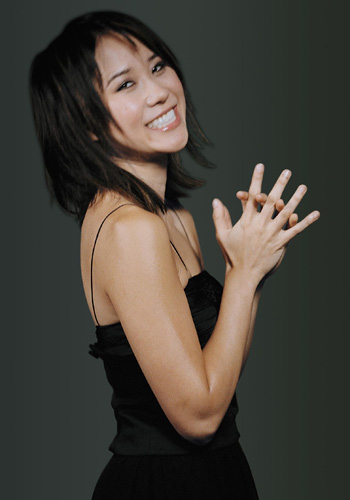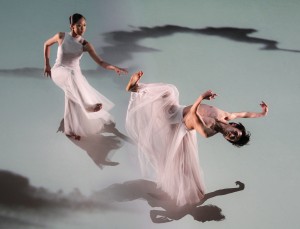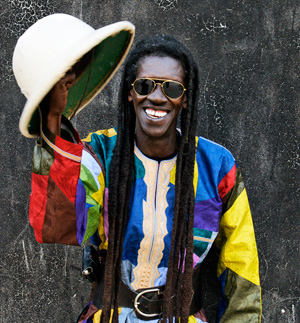[LISTENING GUIDE] Flamenco is a Living Art: Your Guide
 On November 5th UMS will be presenting Diego el Cigala: one of today’s most exciting flamenco singers and musicians.
On November 5th UMS will be presenting Diego el Cigala: one of today’s most exciting flamenco singers and musicians.
I’m Joseph Pratt. For 20 years I’ve performed flamenco and classical guitar at the Amadeus Restaurant in Ann Arbor and I’m delighted to be your guide to this extraordinary music. Though I grew up in Maine and was first introduced to flamenco through television and recordings—my initial exposure was on an episode of Captain Kangaroo–the music left a lasting impression.
Flamenco is a living art form with enigmatic antecedents. This means that while it has roots with Gypsies and other ethnic groups from Andalusia, the area of southern Spain that abuts the Mediterranean, the palette of flamenco has been enriched by hundreds of musicians and dancers from many ethnic origins. This distinctive music has been the soundtrack for the complex and often violent history of the Andalusian underclass. Also, this compelling art form will sound to the listener as though two different times or eras were superimposed: a rich cultural past inspiring a dynamic, fast changing present. Flamenco musicians have learned from the traditions of their cultural past and use those rhythms and voices in their outreach to other musical forms. Where and with whom did this all start?
During the years Spain gorged itself on Aztec gold, an underclass of Arabs, Jews, Roma, North Africans and South Americans poured into the ghettos of Seville bringing with them each their own musical heritage. Not invited to partake of their host country’s riches, the oppressed sang and danced their sorrow in the same spirit as African slaves in the New World. There was a strong current of fatalism in the people who made this music. They generally had no political recourse and were limited in the choices they could make about their own lives. Sorrow, anger, and frustration came out through the music of flamenco: a collective autobiography of hated despots, hopeful lovers, broken men, and distressed women. All the while flamenco incorporates beautiful costumes and cunning virtuosos in it’s juxtaposition of good and evil, just and outlaw which makes flamenco a compelling dynamic experience—one that never fails to raise hairs on the back of my neck.
In many ways then, flamenco was a ‘world music’ before critics coined that term for sounds that bridge form and culture. In recent years Diego el Cigala, an artist originally born in Madrid has added more twists.
Diego el Cigala is particularly good at interpreting what is known as the ‘solea:’ a form of song that expresses the feelings of deep spiritual hardship and is thought to derive from Romani songs carried over generations, from the Indian subcontinent. In a New York Times interview El Cigala says: “Flamenco has to be suffered” and this is very much the tradition of the solea song form. This is not called as ‘cante jundo’ or ‘deep song’ for nothing! While listening, notice his raspy style of singing which is a characteristic flamenco vocal sound known as the ‘voz afilla’. Some would say that voz afilla is the sound of the ripping and tearing of the soul of the singer.
Did you notice how he occasionally claps his hands? Flamenco is a music very rich with rhythm and it has a unique system of accents and beats that can sound unusual to ears conditioned to hearing the music typically played in North America.
Listen to this next video of a song called Flamenco por Lorca . This type of song is called a ‘bulerias’ and is rhythmically similar to the solea but is played at a greater tempo. Take in the floating aural sensation of the flamenco beat. The percussion instrument that that looks like a box is called a ‘ cajon’ which is Peruvian in origin. It was discovered by the great flamenco guitarist Paco de Lucia in the 1970s when he was given a cajon as a gift while on tour in Peru. Paco de Lucia is hailed to be the greatest living flamenco guitarist and has given several UMS sponsored concerts. He liked the sound of the percussion instrument so much that he incorporated it into his own music. The appreciation of the cajon caught on and is now part of the sound of contemporary flamenco. Notice, also, that many hands clap out rhythms called ‘palmas’ and additionally notice the percussive effects played out on the guitar.
Now to Diego el Cigala’s new contribution to the fusion of flamenco where he explores tango. In this video, El Cigala applies voz afilla to the chords and beat of Argentinian tango. While the sound is beautiful to listen to, purists would find this selection not to be authentically Andalusian. Still, its spirit maintains a heat and passion for the flamenco singer to identify in his soul.
Currents of time and history will decide if the tango form will become intertwined with the genre of flamenco. In that spirit, the November 5 performance, which promotes the artist’s new album (Cigala & Tango) may act as a catalyst for an entirely new arm of flamenco – yet another twist in the continuity of a spectacular sound.
11/12 Asia & World Series
Asia
UMS focuses its global programming on four different regions of the world — the Arab World, Africa, the Americas, and Asia — with one region enjoying a particular focus during each season. Following the celebration of the performing arts of the Americas in the 10/11 season, UMS turns its thematic focus to Asia, specifically highlighting artists from China, Taiwan, Inner Mongolia, and India.
Subscription packages go on sale to the general public on Monday, May 9, and will be available through Friday, September 17. Current subscribers will receive renewal packets in early May and may renew their series upon receipt of the packet. Tickets to individual events will go on sale to the general public on Monday, August 22 (via www.ums.org) and Wednesday, August 24 (in person and by phone). Not sure if you’re on our mailing list? Click here to update your mailing address to be sure you’ll receive a brochure.
Yuja Wang, piano
Sunday, October 9, 4pm
Hill Auditorium
Twenty-four-year-old Chinese pianist Yuja Wang is widely recognized for playing that combines the spontaneity and fearless imagination of youth with the discipline and precision of a mature artist. She made her UMS debut in January 2008, just months after graduating from the Curtis Institute of Music, and since then has spent each year criss-crossing the globe with a cavalcade of impressive debuts and awards, including the prestigious Avery Fisher Career Grant, given to select musicians destined for bright solo careers.
Program
Ravel | Miroirs
Copland | Piano Variations
Rachmaninoff | Selected Preludes
Brahms | Sonata No. 1 or No. 3
Water Stains on the Wall
Cloud Gate Dance Theatre
Lin Hwai-min, artistic director
Friday, October 21, 8pm
Saturday, October 22, 8pm
Power Center
Trained in tai chi, meditation, Chinese opera movement, modern dance, and ballet, Cloud Gate Dance Theatre performs a rich repertoire with roots in Asian myths, folklore, and aesthetics, all infused with a contemporary perspective. For this long-awaited UMS debut, Cloud Gate presents Hwai-min’s newest work, Water Stains on the Wall. “Water stains on the wall” is a popular metaphor that represents the highest state in the aesthetics of Chinese calligraphy. Hwai-min and dancers take off from this metaphor and create and abstract work of beauty and magic that stands sublimely on its own.
AnDa Union from Inner Mongolia
Wednesday, November 9, 7:30pm
Michigan Theater
Formed in 2003, AnDa Union’s 14 members all hail from the Xilingol Grassland area of Inner Mongolia, a semi-autonomous region of China. AnDa Union are part of a musical movement that is finding inspiration in old and forgotten folk music from the nomadic herdsman cultures of Inner and Outer Mongolia, drawing on a repertoire of music that has all but disappeared during China’s recent tumultuous past. Its members are accomplished singers and instrumentalists, performing on the traditional horse-head fiddle (tsuur), the maodun chaoer, a three-holed flute, as well as Mongolian versions of the dulcimer, zither, lute, and mouth harp.
Beijing Guitar Duo with Manuel Barrueco
Sunday, November 20, 4 pm
Rackham Auditorium
Meng Su and Yameng Wang are widely noted for their outstanding technique and artistic musicality. They first met at the Central Conservatory in Beijing, where they began studying with the acclaimed professor Chen Zhi as children. Both women have won the Tokyo International Guitar Competition (Yameng Wang won it at age 12), and have received heaps of acclaim and recognition at international guitar events and from other seasoned guitarists, including Sergio Assad who has written and dedicated works to them. In 2008, they went to study with Manuel Barrueco at the Peabody Conservatory of Music in Baltimore and officially established themselves as the Beijing Guitar Duo. Both individually and together, their impressive talents come together to create one of the most excited guitar duos on the scene today.
Chamber Ensemble of the Shanghai Chinese Orchestra
Friday, February 10, 8pm
Rackham Auditorium
The 20 members of the Shanghai Traditional Chamber Ensemble are drawn from the first large-scale modern orchestra of traditional instruments in China. While Chinese stars such as Lang Lang have brought new attention to Western classical music in China, this ensemble provides a window into the traditional Chinese classical music that dates back centuries.
Zakir Hussain and the Master Musicians of India
Fazel Qureshi, tabla and kanjira
Rakesh Chaurasia, bansuri
Dilshad Khan, sarangi
Navin Sharma, dholak
Abbos Kosimov, doyra
Meitei Pung Cholom Performing Troupe (Dancing Drummers of Manipur)
Thursday, April 12, 7:30pm
Hill Auditorium
Zakir Hussain is today appreciated both in the field of percussion and in the music world at large as an international phenomenon. A classical tabla virtuoso of the highest order, his consistently brilliant and exciting performances have not only established him as a national treasure in his own country, but have earned him worldwide fame. For this return appearance, he performs with a host of Indian classical music greats, as well as the dancing drummers of Manipur.
Other World Music
In addition to the events from Asia listed above, UMS presents Goran Bregovic and His Wedding and Funeral Orchestra, which combines a Serbian Gypsy Band, string ensemble, orthodox male choir, and two Bulgarian female vocalists in a wild ride in Hill Auditorium; flamenco star Diego El Cigala; Max Raabe and Palast Orchester, recreating the high style and musical glory of the Weimar era; and Senegalese singer/songwriter Cheikh Lô.
Goran Bregovic & His Wedding and Funeral Orchestra
A Serbian Gypsy Band, Classical String Ensemble,
Orthodox Male Choir, and Two Bulgarian Female Vocalists
Saturday, October 15, 8 pm
Hill Auditorium
“It was party time…a Balkan free-for-all, and the jam-packed auditorium went wild…” (The Jerusalem Post) Balkan music icon and acclaimed film composer Goran Bregovic celebrates the music of Europe’s Gypsy tradition. With a 20-piece ensemble consisting of a Serbian gypsy band, a classical string ensemble, an all-male choir, two Bulgarian female singers and Bregovic’s own electric guitar, the music blends raucous gypsy dance tunes with traditional Eastern European choral music, spinning it all through a rock ‘n roll cycle.
Diego El Cigala
Saturday, November 5, 8 pm
Michigan Theater
Diego is a famous flamenco singer who started off by singing for well-known flamenco dancers but has since “moved to the front,” which in flamenco slang means to sing on one’s own instead of accompanying a dancer. He has collaborated with a variety of musicians, including Bebo Valdés, the Cuban pianist and bandleader with whom he recorded Lágrimas Negras, an album that created a sensation in Spain, becoming one of the best-selling albums in that country’s history and receiving a pile of awards, including five Latin Grammy nominations and the New York Times’ 2003 “Album of the Year” honors.
Berlin Nocturne
Max Raabe & His Palast Orchester
Saturday, March 10, 8pm
Hill Auditorium
“Max Raabe and his 12-piece Palast Orchester are re-creating the music of the Weimar era with verve and class.” (Time Out New York) A nostalgic homage to the legendary nocturnal flair of the Weimar Era, the debonair Max Raabe embodies the high style and music glory of the 1920s and 1930s, all backed by his stellar 12-member band. His art lies in revealing the enigmatic intelligence, ambiguity, musical power and complexity of the “German chansons” from the turbulent Weimar Republic — and then shaking it up with a completely unexpected cover from the contemporary pop realm.
Cheikh Lô
Friday, April 13, 8pm
Michigan Theater
Cheikh Lô is one of the great mavericks of African music. A superb singer and songwriter, as well as a distinctive guitarist, percussionist, and drummer, he has personalized and distilled a variety of influences from West and Central Africa to create a style that is uniquely his own. After emigrating to Paris and then returning to Senegal in the late 1980s, Lô attracted both the attention of and comparisons to Youssou N’Dour, who produced two of his early albums. His signature blend of semi-acoustic flavors — West and Central African, funk, Cuban, flamenco — has been distilled into his most mature, focused, yet diverse statement today, with his husky, sensual voice sounding better than ever.
Return to the complete chronological list.






